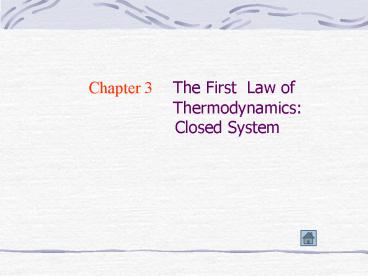Chapter 3 The First Law of Thermodynamics: Closed System - PowerPoint PPT Presentation
1 / 31
Title:
Chapter 3 The First Law of Thermodynamics: Closed System
Description:
Chapter 3 The First Law of Thermodynamics: Closed System 3-4 The First Law of Thermodynamics 3-4 The First Law of Thermodynamics 3-1-1 Conservation of energy ... – PowerPoint PPT presentation
Number of Views:149
Avg rating:3.0/5.0
Title: Chapter 3 The First Law of Thermodynamics: Closed System
1
Chapter 3 The First Law of
Thermodynamics Closed System
2
3-1 Introduction To The First Law of
Thermodynamics
3-1-1 Conservation of energy principle Energy
can be neither created nor destroyedit can only
change forms
3-1-2 The First Law of Thermodynamics Neither
heat nor work can be destroyedthey can only
change from one to another, that is
3
- 3-1-2 The shortcomings of QW
- Cant be employed in engineering calculation
- Cant show the quality difference between heat
and work
In engineering area we would rather use a formula
like this
The net energy transferred from the system
The net energy transferred to the system
-
The net change in the total energy of the system
4
3-2 Work
Work is energy in transition
3-2-1 Definition work is the energy
transfer associated with a force acting through
a distance
Denoted by W ----------kJ work
on a unit-mass basis is denoted by w
w----------kJ/kg work done per unit
time is called power power is denoted as
5
3-2-2 Positive and negative Since work is
the energy transferred between system and its
boundary, then we define that work done by
a system is positive and work done on a system
is negative
6
3-3 Mechanical forms of Work
3-3-1 Moving boundary work
7
work done per unit
P-v Chart
8
Reversible Process
A process that not only system itself but also
system and surrounding keeps equilibrium
System undergoes a reversible process
9
3-3-2 Gravitational work
10
3-3-3 Accelerational work
11
3-3 Heat Transfer
Heat is energy in transition
3-3-1 Definition Heat is defined as the
form of energy that is transferred between two
systems due to temperature difference .
denote as Q ----------kJ heat
transferred per unit mass of a system is denoted
as q----------kJ/kg
We define heat absorbed by a system is positive
12
3-3-2 Historical Background
3-3-3 Modes of Heat Transfer
Conduction
13
Convection
Radiation
14
3-3-4 Thermodynamic calculation of Heat
1. QmC?T
2. Consider
P------the source to do work dV-----the
indication to show if work has been done
the source to lead to heat transfer is T, then
there should be
15
What is dx here?
dx-----the indication to show if heat has been
transferred Consider
We define that x is called entropy and denoted as
S The unit of S is kJ/K Specific entropy is
denoted as s The unit of s is kJ/kg.K
16
Also needs the condition of reversible process!
T-s chart
17
3-4 The First Law of Thermodynamics
3-4-1 Modeling
18
1. The net energy transfer to the system
Win , Qin 2. The net energy transfer from the
system Wout , Qout 3. The total
Energy of the system E
19
3-4-2 The First-Law Relation
(Qin Win) - (Qout Wout) ?E (Qin -
Qout) (Win - Wout) ?E Consider the algebraic
value of Q and W (Qin - ?Qout) - (?Wout -
?Win) ?E Q - W ?E Q ?E W
20
3-4-3 Other Forms of the First-Law Relation
1. Differential Form dQ dE dW
As to a system without macroscopic form energy
dQ dU dW On a unit-mass basis
dq de dw dq du dw
21
2. Reversible Process dQ dE PdV
or dQ dU PdV On a
unit-mass basis dq de pdv
dq du pdv
22
3. Cycle dq du dw
?dq ?du ?dw since ?du 0
then ?d q ?dw if ?d q
0 ?dw 0
This can illustrate that the first kind of
perpetual motion machine cant be produced
23
4.Reversible Process under a Constant Pressure
dQ dU PdV Since
pconst
dQ dU d(pV)
5.Isolated System dE 0
24
3-5 Specific Heats
3-5-1 Definition of specific heat The energy
required to raise the temperature of the unit
mass of a substance by one degree Then
qCT or dqCdT 3-5-2 Specific
heat at constant volume
The specific heat at constant volume Cv can
be viewed as the energy required to raise the
temperature of unit mass of substance by 1 degree
as the volume is maintained constant. At
constant volume , dq du Cv
dTdu
25
3-5-3 Specific heat at constant pressure
The specific heat at constant volume Cp can
be viewed as the energy required to raise the
temperature of unit mass of substance by 1 degree
as the volume is maintained constant pressure.
Similarly, at constant pressure dq
du d wduPdvdud(Pv)dh
Cp dTdh
26
3-5-4 Specific Heats of Ideal-Gas
A Specific heat at constant volume Since
there are no attraction among molecules of
ideal-gas,then u
f (T )
27
B Specific heat at constant pressure
Since u f (T )
hupv f (T
) RT f (
T )
28
3-6 The internal energy, enthalpy of Ideal-Gas
2-7-1 Internal energy and enthalpy
29
We define that u 0 while T 0, then
Obviously, h 0 while T 0, then
Meanwhile
30
We define k Cp / Cv
31
This Chapter is over Thank you!

